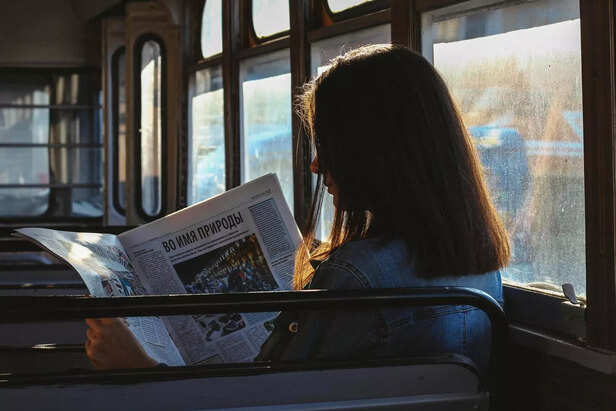Why Indian Women Need Women-Only Public Transport—And It’s Not About Comfort
Riya Kumari | Mar 06, 2025, 23:33 IST
Welcome to the everyday horror show of public transport in India, where women don’t just travel; they strategize survival. And that, dear reader, is why separate public transport for women isn’t just a convenience—it’s an absolute necessity. Women don’t want separate transport. We want public spaces where we don’t have to look over our shoulders every five seconds. But until that utopia arrives (spoiler: not anytime soon), we’ll take the pink buses, the women’s coaches, and the "ladies only" autos. Not because we love them, but because we need them.
Public transport is supposed to be simple. You get on, you get off. Maybe you listen to music, maybe you stare out of the window. What it shouldn’t be is a daily negotiation of fear. It shouldn’t be a space where a woman stands with her arms crossed tightly over her chest, adjusting the strap of her bag like a shield. It shouldn’t be a place where she chooses a seat not based on comfort but on proximity to the safest-looking stranger. And yet, here we are. This is why women’s-only transport exists. Not because we’re delicate. Not because we want special treatment. But because, for too many women, a bus ride isn’t just a bus ride. It’s an assessment of risk. And when the simple act of going from one place to another feels like stepping into a battlefield, we don’t need speeches about equality. We need solutions.
1. A Space of Our Own—But Why Should We Need One?

Women’s-only metro coaches, buses, and trains are not a step forward. They are a reaction. A necessary, urgent reaction, but a reaction nonetheless. They don’t fix the problem; they work around it. They acknowledge that in mixed spaces, women aren’t safe, so the solution is to remove them, rather than remove the danger. That should bother all of us.
Because the ideal world isn’t one where women have their own transport. The ideal world is one where they don’t need it. Where a woman stepping onto a crowded bus at night isn’t a gamble. Where she doesn’t carry keys between her fingers. Where she doesn’t instinctively shrink herself to avoid drawing attention. We don’t want separation. We want safety. And those two things should never have to mean the same thing.
2. Safety vs. Freedom—The Choice We Shouldn’t Have to Make

There is a kind of exhaustion that comes with always being on guard. It’s the exhaustion of every woman who has ever switched seats because of an uncomfortable stare. Of every girl who has pretended to be on a call just to avoid being approached. Of every woman who has sent a “call me if I don’t text in 10 minutes” message before hailing a rickshaw.
The expectation is that we adapt. That we learn to exist within the problem rather than demand that the problem be solved. And we do. Because we don’t have a choice. Because the alternative is to stop moving altogether. And that is the real tragedy of it. That a woman’s right to move freely, to take up space, to just exist without fear—is still something we have to justify.
3. The Future We Should Be Building

Women’s-only transport is a temporary fix to a permanent problem. It gives us a space where we can breathe, but it doesn’t change the fact that the rest of the world is still unsafe. It doesn’t make the streets better lit. It doesn’t change the way some men still see women’s bodies as public property. It doesn’t erase the deeply ingrained belief that harassment is just a part of life.
So yes, we need these spaces. For now. But the real work—the real solution—has to be bigger. It has to be about changing mindsets, about holding perpetrators accountable, about education that teaches respect instead of entitlement. About cities designed with women’s safety in mind, rather than expecting women to design their lives around danger. Because until we fix the why, we’ll always be stuck with the workarounds. And women deserve more than a workaround. They deserve the world.
Every time someone suggests women-only buses, trains, or metro coaches, some dude (always a dude) chimes in with, “But isn’t that discrimination? I thought we were fighting for equality!” But let’s do some quick math: How many men do you know who change their bus routes because they’re scared? How many men text their friends, "Made it home safe" after a night out? Exactly. The fear women feel in public transport isn’t about crowds—it’s about the silent, persistent battle against those who believe a packed space is an excuse to violate boundaries.
1. A Space of Our Own—But Why Should We Need One?

Bus
( Image credit : Pexels )
Women’s-only metro coaches, buses, and trains are not a step forward. They are a reaction. A necessary, urgent reaction, but a reaction nonetheless. They don’t fix the problem; they work around it. They acknowledge that in mixed spaces, women aren’t safe, so the solution is to remove them, rather than remove the danger. That should bother all of us.
Because the ideal world isn’t one where women have their own transport. The ideal world is one where they don’t need it. Where a woman stepping onto a crowded bus at night isn’t a gamble. Where she doesn’t carry keys between her fingers. Where she doesn’t instinctively shrink herself to avoid drawing attention. We don’t want separation. We want safety. And those two things should never have to mean the same thing.
2. Safety vs. Freedom—The Choice We Shouldn’t Have to Make

Women Safety
( Image credit : Pexels )
There is a kind of exhaustion that comes with always being on guard. It’s the exhaustion of every woman who has ever switched seats because of an uncomfortable stare. Of every girl who has pretended to be on a call just to avoid being approached. Of every woman who has sent a “call me if I don’t text in 10 minutes” message before hailing a rickshaw.
The expectation is that we adapt. That we learn to exist within the problem rather than demand that the problem be solved. And we do. Because we don’t have a choice. Because the alternative is to stop moving altogether. And that is the real tragedy of it. That a woman’s right to move freely, to take up space, to just exist without fear—is still something we have to justify.
3. The Future We Should Be Building

Bus
( Image credit : Pexels )
Women’s-only transport is a temporary fix to a permanent problem. It gives us a space where we can breathe, but it doesn’t change the fact that the rest of the world is still unsafe. It doesn’t make the streets better lit. It doesn’t change the way some men still see women’s bodies as public property. It doesn’t erase the deeply ingrained belief that harassment is just a part of life.
So yes, we need these spaces. For now. But the real work—the real solution—has to be bigger. It has to be about changing mindsets, about holding perpetrators accountable, about education that teaches respect instead of entitlement. About cities designed with women’s safety in mind, rather than expecting women to design their lives around danger. Because until we fix the why, we’ll always be stuck with the workarounds. And women deserve more than a workaround. They deserve the world.
